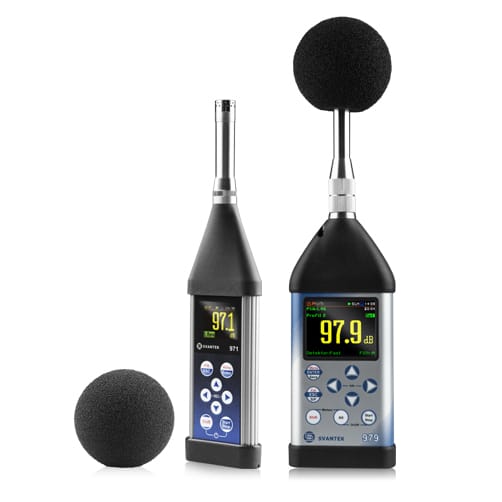What is office noise?
Noise in the office can be generated by many different sources. It is necessary to distinguish between noise coming from outside and noise generated inside the room. The first one may be caused by, among others, air conditioning installation, street or railway traffic outside the window, a construction site or an elevator. Noise generated inside a room can be the result of devices such as printers or computers, but it can also be generated by telephone conversations, computer keyboard sounds, or the noise of a kettle. Noise in the workplace can have a significant impact on employee performance and efficiency. In acoustics, offices are treated as rooms that must meet appropriate building standards.
Why measure noise levels in the office?
The noise level in an office should be controlled to protect employees’ hearing and ensure optimal working conditions. In Poland, the Regulation of the Minister of Economy and Labor of August 5, 2005, concerning occupational safety and health in relation to noise and mechanical vibrations, sets specific exposure limits to prevent hearing damage. In general, legal occupational exposure limits focus on preventing hearing loss, while acoustic standards aim to enhance concentration and productivity, making effective noise control a key factor in office design and compliance.
For office spaces, ISO 3382-3:2012 and BS 8233:2014 recommend background noise levels of 35–45 dB(A) to ensure speech intelligibility, reduce distractions, and maintain employee well-being. If office noise originates from external sources, such as road traffic or industrial activity, acoustic insulation should be assessed. In Poland, this is regulated by the Regulation of the Minister of Infrastructure of April 12, 2002, which defines building façade insulation requirements. In the EU, ISO 16283-3 and ISO 717-1 provide standardized methods for measuring façade sound insulation to ensure compliance with recommended indoor noise levels.
Who performs noise level measurements in the office?
Noise measurements in the office are performed by specialists in acoustics or environmental engineering. It is best to use the services of accredited acoustic laboratories. Measurements made by such a laboratory are the ideal starting point for pursuing your case in court or another institution responsible for it. By choosing accredited acoustic laboratories, we are guaranteed that noise measurements will be made following the standards and guidelines in force in a given country and that the results obtained will be binding.
What are the standards for noise in offices?
In Poland, office noise standards are divided into workplace exposure limits and building acoustic requirements. The Regulation of the Minister of Economy and Labor (August 5, 2005), based on PN-N-01307:1994, sets workplace limits at 55 dB(A) for administrative offices and 65 dB(A) for precision workspaces to protect employees from excessive noise exposure. These limits align with EU Directive 2003/10/EC, which sets occupational noise exposure thresholds mainly for industrial environments. Separately, building acoustic standards ensure proper sound insulation. The Regulation of the Minister of Infrastructure (April 12, 2002), along with PN-B-02151-2:1987, specifies that indoor noise levels in administrative offices should not exceed 40 dB(A) during the day, reflecting requirements for quiet working conditions in furnished rooms with closed doors and windows.
Across Europe and internationally, office noise standards focus on speech intelligibility, productivity, and acoustic comfort. ISO 3382-3:2012 measures sound propagation in open-plan offices, while BS 8233:2014 (UK) recommends 45–50 dB(A) for open-plan offices and 35–40 dB(A) for private offices and meeting rooms. French NF S31-199:2016 defines acceptable background noise and speech privacy requirements in modern office spaces. Additionally, the WELL Building Standard and ANSI/ASA S12.2-2019 (US) suggest limiting background noise to 35–45 dB(A) to reduce distractions and improve concentration. Where external noise is a concern, ISO 16283-3 and ISO 717-1 establish methods for measuring façade insulation to ensure compliance with recommended indoor noise levels. These standards prioritize acoustic comfort and productivity rather than just preventing hearing damage.
How should noise in the office be measured?
Office noise measurement adheres to national standards and regulations designed to protect employees from excessive noise exposure and ensure a conducive working environment. In Poland, noise in the office should be measured in accordance with the PN-B-02156:1987 standard “Building acoustics – Methods for measuring sound level A in buildings.” This standard defines the arrangement of measuring points during the measurement, the number of measurements to be taken and the requirements that must be met in order to perform the measurement correctly. According to the standard, the average A-weighted sound level for a reference period T and the maximum sound level are usually recorded. Before and after the measurement, the measurement track must be checked using a sound calibrator. In addition to noise from specific sources, the background noise in the room must also be measured.
How long does it take to measure noise in an office?
The duration of an office noise measurement depends on many factors and can vary. The measurement process begins with an on-site inspection, the selection of measuring points and the fulfillment of standard requirements. The duration of the measurement also includes the time needed to process the results, estimate the measurement uncertainty and prepare the report. The whole procedure can take from a few to several days.

